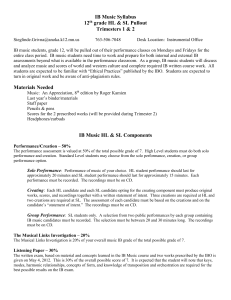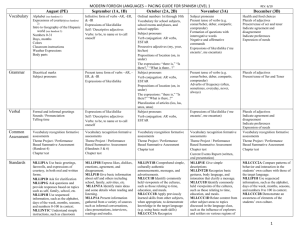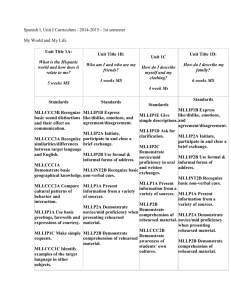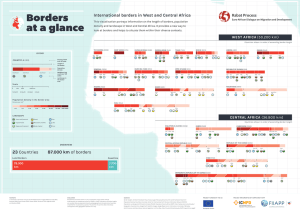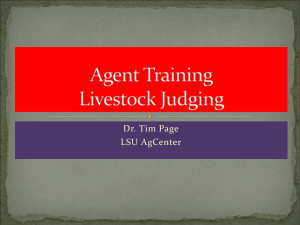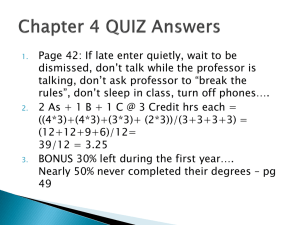Strand Content Standard
advertisement
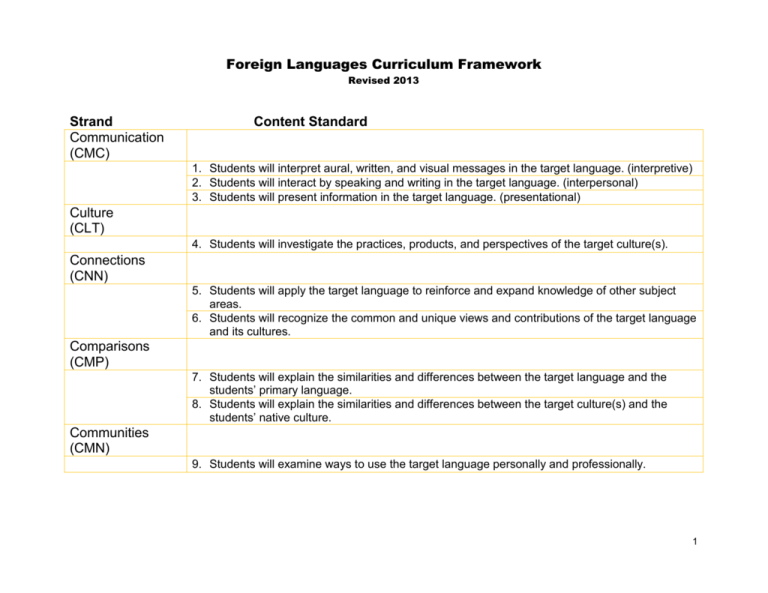
Foreign Languages Curriculum Framework Revised 2013 Strand Communication (CMC) Content Standard 1. Students will interpret aural, written, and visual messages in the target language. (interpretive) 2. Students will interact by speaking and writing in the target language. (interpersonal) 3. Students will present information in the target language. (presentational) Culture (CLT) 4. Students will investigate the practices, products, and perspectives of the target culture(s). Connections (CNN) 5. Students will apply the target language to reinforce and expand knowledge of other subject areas. 6. Students will recognize the common and unique views and contributions of the target language and its cultures. Comparisons (CMP) 7. Students will explain the similarities and differences between the target language and the students’ primary language. 8. Students will explain the similarities and differences between the target culture(s) and the students’ native culture. Communities (CMN) 9. Students will examine ways to use the target language personally and professionally. 1 Modern Languages I (Spanish I) CMC.1.MLI.1 Recognize elements of speech intonation patterns pitch rhythms sounds syllables tones CMC.1.MLI.2 Recognize orthographic characters or symbols (e.g., accent mark, umlaut, Chinese stroke order, radical, Cyrillic characters) CMC.1.MLI.3 Recognize cognates, place names, and borrowings CMC.1.MLI.4 Recognize language registers (e.g., formal, informal) CMC.1.MLI.5 Follow simple directions (e.g., classroom commands, procedures) CMC.1.MLI.6 Understand basic idiomatic expressions CMC.1.MLI.7 Interpret the principal message of gestures, nuances, and intonation CMC.1.MLI.8 Use reading and listening strategies to enhance comprehension (e.g., cognates, contextual clues, visual cues, inferences, predictions) CMC.1.MLI.9 Identify central idea(s) and specific information from a variety of appropriate texts and visual media on familiar topics CMC.1.MLI.10 Identify central idea(s) and specific information from a variety of auditory sources with or without visual cues CMC.1.MLI.11 Interpret authentic materials CMC.1.MLI.12 Draw conclusions from a variety of simple oral, visual, and textual sources, citing evidence CMC.2.MLI.1 Interact effectively in a range of conversations and collaborations in the appropriate time frames CMC.2.MLI.2 Engage in simple conversations using cultural conventions and social conventions courtesy phrases culturally appropriate greetings and farewells gestures introductions learned phrases idiomatic expressions CMC.2.MLI.3 Exchange information through dialogue or in writing about familiar topics clothing daily life family and friends feelings and emotions food likes and dislikes needs and wants parts of the body pastimes personal information time and calendar weather 2 CMC.2.MLI.4 Apply conversational strategies to increase understanding in rehearsed, familiar situations ask basic questions (e.g., who, what, when, where, why, how, how much, how many) ask for repetition request clarification CMC.2.MLI.5 Use survival phrases and gestures to meet basic needs (e.g., directions, simple requests) CMC.2.MLI.6 Apply numeric concepts in context age cardinal numbers dates time CMC.3.MLI.1 Describe people, places, actions, and objects CMC.3.MLI.2 Write about familiar topics (e.g., labels, lists, notes, short paragraphs) CMC.3.MLI.3 Use acquired language skills through brief rehearsed presentations (e.g., skits, songs, poems, show and tell, mock interviews, speeches) CMC.3.MLI.4 Create visual and/or multimedia presentations about familiar topics (e.g., menu, poster, slide show, podcast, brochure, blog, graphic organizer) CMC.3.MLI.5 Use elements of the target language effectively according to language development level about simple familiar topics(e.g., grammar, pronunciation, orthography/spelling, syntax) CLT.4.MLI.1 Demonstrate practices of the target culture(s) by identifying culturally appropriate behavior (e.g., verbal/nonverbal greetings, gestures, customs) identifying differences among target culture(s) (e.g., greetings, food preparation) recognizing shared cultural practices (e.g., common holidays, rituals, traditions) CLT.4.MLI.2 Identify the products of the target culture(s) global influences (e.g., automobiles, composers, fashion, fireworks, dance, sports) intangible products (e.g., philosophy, law, entertainment, educational systems) tangible products (e.g., architecture, art, food, clothing, technology) CLT.4.MLI.3 Identify the perspectives of the target culture(s) reflected in practices (e.g., value of education, rites of passage, holidays, family units) products (e.g., literature, art, music, housing, transportation) CLT.4.MLI.4 Examine the factors that influence practices, products, and perspectives of the target culture(s) (e.g., climate, geography, history, politics, environment, economics) CLT.4.MLI.5 Identify practices, products, and perspectives among target culture(s) CLT.4.MLI.6 Identify the written, visual, and/or performing arts of the target culture(s) (e.g., plays, poems, art, music, movies) CLT.4.MLI.7 Research major institutions, contemporary and historical figures, contributions, and/or time periods of the target culture(s) CNN.5.MLI.1 Recognize terms and concepts from other disciplines (e.g., climate, geography, measurements, money, animals, musical instruments) CNN.5.MLI.2 Recognize vocabulary from the target language found in other disciplines (e.g., Fahrenheit, kindergarten, laissez-faire, coup d’état, mural, mesa, yin yang, tofu, opera, concerto, Kremlin, balalaika, haiku, algebra) CNN.5.MLI.3 Apply skills and content learned from other disciplines (e.g., temperature conversion, mathematical computation) CNN.6.MLI.1 Identify basic characteristics that make target culture(s) unique (e.g., dialect, regional accent, dietary habit) CNN.6.MLI.2 Recognize unique cultural characteristics present in authentic or adapted texts (e.g., songs, folk tales, short stories, poems) CNN.6.MLI.3 Identify cultural and linguistic relationships between the target culture(s) and the students’ own culture (e.g., place names, surnames) CNN.6.MLI.4 Recognize the existence of other worldviews (e.g., political, social, artistic) 3 CNN.6.MLI.5 Recognize contributions from the target culture(s) (e.g., pasteurization, Braille, printing press, gun powder, acupuncture, chocolate, Theory of Relativity, Periodic Table of Elements, piano, bicycle, crystallization, exploration) CMP.7.MLI.1 Identify cognates, false cognates, borrowings, and shared derivatives CMP.7.MLI.2 Compare basic idiomatic expressions CMP.7.MLI.3 Recognize the similarities and differences in simple language structure (e.g., word order) CMP.7.MLI.4 Identify the use of register CMP.7.MLI.5 Compare writing systems (e.g., accent marks, punctuation, characters, symbols, numbers, handwriting) CMP.7.MLI.6 Compare linguistic sounds (e.g., sound-letter correspondence, tones, pitch, intonation) CMP.8.MLI.1 Identify daily living patterns (e.g., meals, transportation, shopping, greeting) CMP.8.MLI.2 Compare and contrast major holidays and celebrations CMP.8.MLI.3 Recognize different meanings of gestures and body language CMN.9.MLI.1 Recognize the use of the target language in the community (e.g., place names, cuisine, products) CMN.9.MLI.2 Identify ways to use the target language in the community (e.g., perform songs and skits, present arts and crafts) CMN.9.MLI.3 Identify global competency skills and relate them to possible career pathways CMN.9.MLI.4 Identify authentic activities of the target culture(s) (e.g., sports, games, cooking, music, media) CMN.9.MLI.5 Explain the advantages of foreign language proficiency in college and/or career (e.g., occupation, education, travel) CMN.9.MLI.6 Identify ways to communicate and/or collaborate with speakers of the target language (e.g., pen pals, e-pals, audio recordings, video recordings) CMN.9.MLI.7 Research globally influential individuals or groups from the target culture(s) (e.g., actors, musicians, artists, politicians, athletes) 4 Adapted text Aspect Authentic Blog Borrowing Case Circumlocution Cognate Colloquialism Connected discourse Convention Cultural convention Cyrillic Declension Derivative Dialect E-pal False cognate Fluid word sequence Global competency skill Idiomatic expression Glossary for Modern Languages I-IV Print, non-print, or digital material, source, or medium in the target language, not necessarily from a country or culture where the target language is spoken; may include translations or materials modified, created, or simplified to meet a specific educational purpose In Russian, a form of a verb occurring only in the past and future tenses to indicate the status of the action’s completeness, duration, or recurrence; Russian uses a perfective aspect to indicate completed actions and an imperfective aspect to denote actions that are incomplete, recurring, or of indefinite duration Original; without modification; having an undisputed, genuine origin; designed by native speakers for native speakers; authentic materials, sources, or texts are those that have been developed specifically for native speakers, including print, audio and visual materials; representative of the real world An online journal; literally, a web log A word or phrase adopted from one language into another with no significant change in spelling or pronunciation A grammatical category whose value reflects the grammatical function performed by a noun or pronoun in a phrase, clause, or sentence A communicative strategy that is used to describe or talk around a concept or action when the exact word is not known (e.g., “the thing that stops a car” for “brakes”) A word from different languages that sounds or looks similar and has a similar meaning, typically evolved from a common origin (e.g., fabuloso, liberté, Haus, сестра) A word or phrase unique to a geographic region, culture, or subculture Sustained formal discussion of a subject in speech or writing A symbol, theme, motif, or archetype A custom or practice applied by a specific culture Alphabet used by several East European and Central Asian languages, including Russian In Latin, the division of nouns into groups based on genitive singular form; in Russian, the pattern of inflections of nouns and adjectives to indicate grammatical number, gender, and case A word formed from existing words, bases, or roots; in Latin, a word or family of words which have the same Latin base (e.g., deduce = de + ducere ;conduct = cum + ducere, induct = in + ducere) Distinct differences of a language which are characteristic of a particular group of the language’s speakers Similar to pen pal except that communication takes place using electronic media A word that looks and sounds similar to a word in more than one language but does not have the same meaning A feature of sentence structure that allows word sequence to be changed freely to achieve differences in emphasis Knowledge of languages and cultures, which gives one the ability to engage successfully with global affairs, communities, and events An expression which functions as a single unit and whose meaning cannot be translated word for word; a group of words that means something other than the literal translation 5 Glossary for Modern Languages I-IV Infix Inflection Intangible product Intonation Mood Nuance Orthography Perspective Pitch Place name Podcast Practice Product Proverb Radical Register Social convention Syntax Tangible product Target culture(s) Tense Tone Tones (Mandarin Chinese) Wiki An affix inserted inside a word stem (an existing word); it contrasts with a prefix or suffix The ways words change in context (e.g., declension, conjugation) An abstract cultural element of a society (e.g., legal system, education system, religion, music) The use of vocal inflections or pitch to contribute to meaning; the pattern or melody of pitch that changes in connected speech, especially the pitch pattern which distinguishes kinds of sentences or speakers of different languages A characteristic of a verb that refers to how the writer or speaker presents ideas (indicative, imperative, subjunctive) A subtle difference in meaning The correct use of writing, symbols, and spelling An attitude or worldview associated with a particular culture or cultures; a traditional idea, attitude, meaning, or value of members of that society The degree to which a sound has a high or low quality A proper noun such as the name of a city An auditory or visual electronic file available via the Internet A pattern of behavior accepted by a society; knowledge of what to do, when, and where A concrete (tangible) or abstract (intangible) cultural element of a society A short saying expressing a well-known idea or truth (e.g., a bird in the hand is worth two in the bush, all that glitters is not gold) In Mandarin Chinese, the semantic component of a character A manner of addressing another according to the title, relationship, or social situation A custom or practice widely observed within a group The order of words required to make grammatically correct sentences; in Russian, the organization of words to create coherent, properly structured sentences A concrete cultural element of a society (e.g., literature, foods, tools, dwellings, clothing) Any culture or cultures found in countries or regions where the target language is spoken, including subcultures that don’t speak the target language A characteristic of a verb that indicates the time of the action or state of being that a verb expresses A pitch used to distinguish words The relative heights of pitch with which a syllable or word is pronounced to distinguish meaning; every syllable has a tone, and the same syllable pronounced with different tones can have different meanings; the four basic tones in Mandarin are high level (first tone), rising (second tone), falling-rising (third tone), and falling (fourth tone) A collaborative web site for use in knowledge management, which may be edited by users 6

